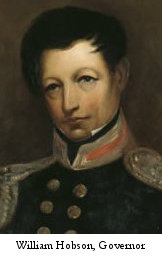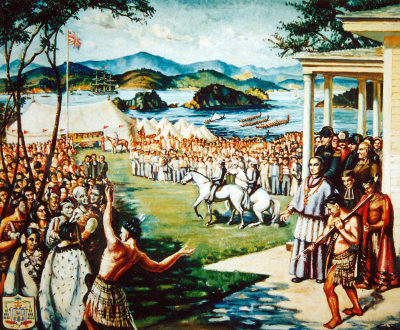APAC167
From Marist Studies
The Treaty of Waitangi

- For years New Zealand had been de facto a British possession. English, Scottish and Irish people entered in large numbers and settled everywhere. There was barely a Maori tribe, wrote Pompallier in 1840, that did not have at least one British subject living nearby. The Maori chiefs who ruled over their tribes had no authority over the settlers. Unruly adventurers as many of them were, they recognized no authority at all, or, at the most, the far away British governor of New South Wales. Small British settlements, says Pompallier, can be found in every bay.
- Then, on 9 January 1840, the corvette Herald entered the Bay of Islands. It hoisted the British flag and the ship’s guns gave the salute. The officer in charge, Captain Hobson, acting as lieutenant governor, on behalf of the governor of New South Wales, called an assembly of local chiefs and settlers for the 5th of February near the mouth of a stream, called Waitangi. Pompallier joined the convocation, in full purple dress, accompanied by Servant, who had just a few days earlier come across from the Hokianga. They had not been invited and their arrival raised a few eyebrows. But Captain Hobson had an officer’s respect for rank and, to the annoyance of the Methodist ministers, offered Pompallier, ‘the one lord that New Zealand could boast’ a place of honour at the proceedings.[1]

- Hobson asked the Maori chiefs if they were prepared to become subjects of the British Queen and accept to live under her protection. Pompallier was asked by several chiefs if they should or should not sign. Pompallier explained that he and his missionaries had come only for the salvation of souls and were there for the service of all people. He kept a strictly neutral position and refused to express an opinion.
- As Servant wrote to Colin a month after the event, the large majority of Maori chiefs made it clear in their typical, colourful eloquence, they did not want the Queen of England to extend her authority over them. If there was to be a British authority, let it extend itself only over the British settlers who had intruded upon their lands. They complained of the extensive lands the strangers had appropriated and they would gladly give back the bibles they had received in order to regain their land. Some asked Hobson to leave their country. In the end, Servant writes, more moderate speakers took over and stressed the advantages of accepting British sovereignty. The next day, many signed.
- Hobson went around the country and held convocations on many places. Servant wrote that in Hokianga one chief asked the lieutenant governor if a Maori chief could do the same, go to England and just proclaim sovereignty there?
- Pompallier was convinced that the Maoris did not and could not understand the full implications of the event. Anyhow, it was a farce, he said, to ask the question after raising the flag followed by the salvo of naval guns. He had his doubts whether what he called the prise de possession would get international recognition. He noted afterwards that American and French warships entered the Bay of Islands without acknowledging British sovereignty[2] and he expressed the fear that the British act could lead to international tensions but he admitted that the new governor had been most respectful. When asked, Hobson announced that the Catholic Church could proclaim its religion all over New Zealand and would receive the same protection as other churches. Adding insult to injury, Hobson asked the Methodist missionary Henry Williams to convey this message to the Maori chiefs present. [3] The mission ship was allowed to anchor everywhere without charge and mission goods could be brought in free of duty. In fact, Pompallier admits, the prise de possession has brought law and order and that can only be for the good. Having been scrupulously impartial, the Catholic Church got no blame from the Maoris for what had happened, while criticism was frequently directed at the Protestant ministers who had openly favoured the treaty. What really upset many Maoris, was the presence of British soldiers on their lands.[4]
A great missionary [5]
- Treaty or no treaty, Pompallier pursued his missionary work with vigour. He would have preferred to make a tour to the South Island as well as exploring the east coast of the North Island, but as he had no ship and had to hire one at great cost, he limited himself to the North. In order to assure continuity of religious services and instructions he called in Catherin Servant from the Hokianga mission who was the best Maori speaker of the moment. Viard and Brother Michel he took with him as well as a Maori catechist, Romano.
- From the Bay of Islands he went south along the east coast. In the Bay of Plenty he received an enthusiastic welcome in Tauranga where he delighted the local people with a pontifical Mass, and enrolled several hundred catechumens. He went for several days walking into the interior, climbed mountains and was carried through swamps. His reputation had preceded him and he was respectfully received on many places. He then sailed on to Ohiwa harbour from where he walked to Opotiki where a chief from the Bay of Islands had married into a local tribe and had already built a chapel. After successful visits to tribes near Whakatane he moved back up the coast and spent several weeks in the Coromandel Bay, calling at coastal villages and walking inland, staying two or more days at several places.
- Viard described Pompallier amid the Maoris as follows: ‘When they are near His Lordship they cannot bear to part company with him. `Epikopo, I am hungry` they say, and without more ado sit down to table. And Epikopo gives them to eat what he has, without his courtesy being exhausted and without his zeal ever being wearied.’ [6] The description that Joseph Luzy gave two years later of Pompallier in Wallis can also help us picture him (minus the kava and the banana) in the Maori villages: ‘Forgetful of his rank he sits down among his flock, drinking kava, eating with his fingers from a banana leaf on the ground.’ [7]
- When possible his missionary tours were followed by foundations and appointments. In October 1838 he had visited the Kaipara district overland. In May 1840 he sent Petit and Michel Colombon there to start a mission. In his first sea trip, to the North, in September 1839, he prepared the ground in Whangaroa and in January 1840 he sent Épalle, Petitjean and Brother Élie to open a station there. After this trip South he appointed Viard in Tauranga. As he explained to Colin, he would not send his missionaries anywhere until he had made the first contacts himself and broken the ground. [8] This was Pompallier at his best. This is where he was happy. ‘I enjoy the missionary tours in New Zealand, and the dangers involved as if I were in heaven’. [9] A great missionary indeed!
- In the bishop’s absence the two naval vessels he had been waiting for, the Astrolabe and the Zélée under Captain Dumont d’Urville, paid a call to the Bay of Islands. The captain carried Colin’s letters of May and November 1837 with the fifty golden Spanish doublons, that Father Liausu in Valparaiso had entrusted to him for Pompallier. [10] Petit rose to the occasion. He received the captain at the mission and celebrated a solemn high Mass at which Dumont d’Urville and a detachment of sailors attended.
Notes
- ↑ Simmons, op. cit. p. 43.
- ↑ Dumont d’Urville, on the Astrolabe, only heard of the prise de possession when entering the Bay of Islands in March or April. He found Hobson not at home and went to see Hobson’s secretary to whom he explained that in the absence of instructions from his government he was not able to recognize British sovereignty. Cf. Jore, op. cit. II, p. 87.
- ↑ King, op. cit. p. 163.
- ↑ LRO, doc. 59 [13 - 15]. Servant to Colin, LRO, doc. 52 [14 – 16] & doc. 55 [9].
- ↑ I owe this section in large part to Simmons, op. cit. 45 - 48
- ↑ This quote in Simmons is from 06.01.40, i.e., before the present trip, cf. LRO, doc. 45 [3]. But it is so graphic that it must be true and typical for the way Pompallier got along with the Maori people.
- ↑ LL 26.05.42
- ↑ LRO, doc. …..
- ↑ LRO, doc. 60 [22].
- ↑ LRO, doc. 59 [4]. Simmons, op. cit. p. 48. On the letters and the money, cf. above, p. 51, 56, 65 & 118. On the visit of Dumont d’Urville, cf. Jore, op. cit. II, pp. 87 – 90.
| Previous Section | A Piety Able to Cope | Next Section |